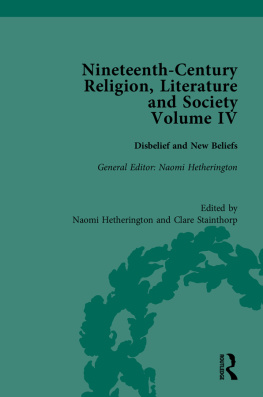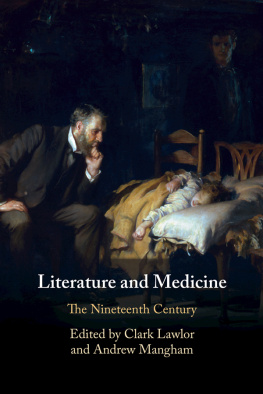NINETEENTH-CENTURY RELIGION, LITERATURE AND SOCIETY
NINETEENTH-CENTURY RELIGION, LITERATURE AND SOCIETY
General Editor:
Naomi Hetherington
Volume I
Traditions
Edited by Rebecca Styler
First published 2020
by Routledge
2 Park Square, Milton Park, Abingdon, Oxon OX14 4RN
and by Routledge
52 Vanderbilt Avenue, New York, NY 10017
Routledge is an imprint of the Taylor & Francis Group, an informa business
2020 selection and editorial matter, Naomi Hetherington and Rebecca Styler; individual owners retain copyright in their own material.
The right of Naomi Hetherington and Rebecca Styler to be identified as the author[/s] of the editorial material, and of the authors for their individual chapters, has been asserted in accordance with sections 77 and 78 of the Copyright, Designs and Patents Act 1988.
All rights reserved. No part of this book may be reprinted or reproduced or utilised in any form or by any electronic, mechanical, or other means, now known or hereafter invented, including photocopying and recording, or in any information storage or retrieval system, without permission in writing from the publishers.
Trademark notice: Product or corporate names may be trademarks or registered trademarks, and are used only for identification and explanation without intent to infringe.
British Library Cataloguing-in-Publication Data
A catalogue record for this book is available from the British Library
Library of Congress Cataloging-in-Publication Data
A catalog record for this book has been requested
ISBN: 978-1-138-56315-5 (set)
eISBN: 978-1-351-27236-0 (set)
ISBN: 978-1-138-57280-5 (volume I)
eISBN: 978-1-351-27228-5 (volume I)
Typeset in Times New Roman
by Apex CoVantage, LLC
To Julie Melnyk (19642017)
whose work on nineteenth-century religion and literature was
an inspiration to all of us and with whom we had been
looking forward to working on this collection
CONTENTS
PART 1
Evangelical Religion
PART 2
Anglican Developments
PART 3
Roman Catholicism
PART 4
Scottish Presbyterianism
PART 5
Forms of Dissent
PART 6
New Nonconformist Movements
PART 7
Judaism
PART 8
Religious Traditions from Asia
PART 9
Interpretive Traditions
Guide
I would like to thank the University of Lincoln for financial support for library visits to the British Library, London, the Library of the Society of Friends, London, and the Gladstone Library in Hawarden, Flintshire. It is also my pleasure to thank the helpful staff at these and other institutions including in Special Collections at the University of Leicester, and in particular Karen Waddell of the British Library Newsroom for tracing a missing reference as well as Graham Johnson of Special Collections at the University Library of Manchester for locating and sending me copies of the Brethren sources.
I am grateful to Garmonn Gruffudd at Y Lolfa Press for arranging permission to reproduce Gwynfor Evanss translations of hymns by Williams Pantycelyn and Ann Griffiths.
I would like to thank Leon Charikar for his helpful explanations of Hebrew script and vocabulary. Finally, I would like to express my gratitude to Kimberley Smith, Simon Alexander and Sarahjayne Smith at Routledge for their oversight of this project from its early days to its successful completion in what has been an unprecedented global crisis.
Thanks are due also to the University of Pennsylvania Press for permission to reproduce Lily H. Montagus article Spiritual Possibilities of Judaism Today from The Jewish Quarterly Review 11:2 (Jan 1899).
I am grateful to Calderdale Council for kind permission to reproduce Hymn Thirteenth from the National Chartist Hymnbook (Rochdale: [1845]) from the National Chartist Hymn Book: From Weaver to Web: Online Visual Archive of Calderdale History: https://www.calderdale.gov.uk/wtw/.
Rebecca Styler
The publishers would like to thank the following for permission to reprint their material:
Y Lolfa Press for permission to reprint William Williams Pantycelyn, Rwyn edrych dros y bryniau pell (I look across the distant hills), in Gwynfor Evans (ed.), Land of My Fathers: 2000 Years of Welsh History (Talybont: Y Lolfa Press, 1992), p. 338.
Y Lolfa Press for permission to reprint Ann Griffiths, Welen sefyll rhwng y myrtwydd (See him stand among the myrtles), in Gwynfor Evans (ed.), Land of My Fathers: 2000 Years of Welsh History (Talybont: Y Lolfa Press, 1992), pp. 3467.
Jewish Quarterly Review for permission to reprint Lily Montagu, extract from Spiritual Possibilities of Judaism Today, Jewish Quarterly Review, 11, 2 (January 1899), pp. 21630.
Central Library & Archives, Calderdale Council, for permission to reprint Anon., Hymn Thirteenth, National Chartist Hymnbook (Rochdale: [1845]), p. 12. www.calderdale.gov.uk/wtw
Disclaimer
The publishers have made every effort to contact authors/copyright holders of works reprinted in Nineteenth-Century Religion, Literature and Society. This has not been possible in every case, however, and we would welcome correspondence from those individuals/companies whom we have been unable to trace.
The last twenty-five years have seen a religious turn in nineteenth-century studies. Where previously religion has tended to be overlooked or dismissed as an oppressive force to be sloughed off as societies modernise, it is now taken seriously as a subject of study. This can be attributed, in large part, to the public re-emergence of religion following the events of the late twentieth and early twenty-first centuries. Post 9/11, predictions of a worldwide secular society no longer appear plausible.1 Although various revisionary accounts of the secularisation thesis have been put forward, it retains few supporters in its orthodox form, namely that religious decline is a prolonged unilinear and inevitable consequence of modernity.2 This has particular significance for scholars of the nineteenth century since it was traditionally taken as the turning-point in the history of secularisation. No longer perceived as the quaint anteroom to a secular present, the nineteenth century can be studied for the richness and complexity of its religious life.3 However, what religion is understood to be in this period is far from self-evident.
Commonly applied to beliefs, practices, experiences, institutions, texts and traditions, the meaning of the term religion may appear obvious. Yet, as the anthropologist Talal Asad has pointed out, the notion that religion has a set of generic features and functions has a specific Christian history.4 The first systematic attempts to produce a universal definition of religion occurred in the seventeenth century as a result of the threat posed to the unity and authority of the Roman Catholic Church by the Protestant Reformation in Europe.5 Understood in terms of beliefs about a supernatural power, and related practices and ethics, that existed in all societies, religion could be conceived as a set of propositions, to which believers gave assent, and which could therefore be judged and compared as between different religions that were encountered through trade and colonisation.6 The rise of comparative religion as an academic discipline in the final decades of the nineteenth century created an evolutionary framework within which Protestantism became the measure of religious advancement. Tomoko Masuzawa has shown how this led to the invention of world religions as a universal category which simultaneously represents religion in Western European terms.7 Furthermore, in removing the material practices of religion from specific historical and political contexts, the discourse of world religions spiritualises and abstracts them by turning them into expressions of something timeless and suprahistorical.8






